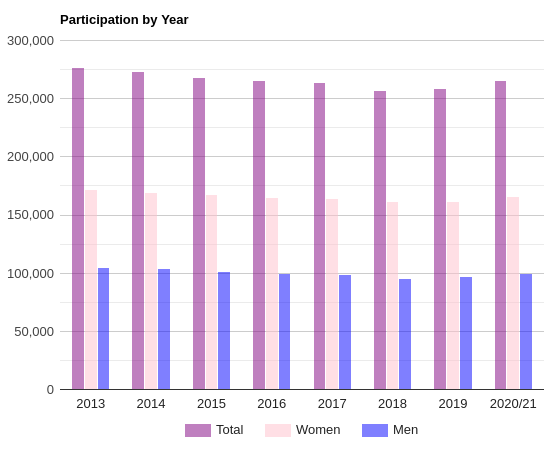Next for my year-end statistics and analysis is to look at participation numbers. I've done this analysis in past years, so I'm continuing the same methodology this year which is to look at unique players that played in the main Adult leagues, i.e. 18 & Over, 40 & Over, 55 & Over, and 65 & Over.
This is clearly an odd year to be looking at participation with the USTA treating 2020/2021 as one rating period or "year", and 2020 being abbreviated due to COVID, and 2021 still affected as some players still stayed away to limit interaction with outsiders.
So should 2020/2021 be treated as one year? Or should each year be looked at individually? In general, I'm going to treat it as one year in this post, but I'll split out the years a little bit to see what we can learn.
First, here is participation across all the divisions and treating 2020/2021 as one period.
Using this approach, participation in 2020/2021 is up over 2019! In fact, it is back to 2016 levels! Does this mean the steady decline in participation is over and there may be some growth?
I'm not sure that is a reasonable conclusion as combining any other two years would show significantly higher participation in that combined period, so combining 2020/2021 and see a slight bump should not be construed as real growth.
To illustrate that, here is what the chart looks like if each year is independent.
This more clearly shows what really happened, COVID wreaked havoc with participation in 2020, it is almost surprising it wasn't lower, and then 2021 has clearly recovered but is still well short of where things were in 2019.
It is obviously not fair to judge 2020 or 2021 as separate years against 2019, but combining them can be misleading too as it masks what is likely still a decline in participation. I think I've shown the effect of COVID with the chart above though, so for the rest of this post I'll look at the different divisions using a combined 2020/2021.
Next, we look at unique players in 18 & Over.
This shows a slight decline from 195K to 193K, even with the combined 2020/2021. So the same concern I've noted in past years remains, it appears either younger folks aren't joining USTA and playing league, or as existing players age they are choosing not to play 18 & Over.
Next, 40 & Over.
And here is where we see growth that makes up for the decline in 18 & Over. The player population is aging and more are becoming eligible for 40 & Over it appears, and they do take that opportunity to play it.
Last, 55 & Over.
Interestingly there is a decline here even with the combined years. Either there are just fewer players due to age, or those 55+ were more leery of coming back due to COVID concerns.
What do you think? What does this tell us? Anything? Or due to COVID too many variables to make any conclusions?
Note: These are statistics from the data I've gathered and may not exactly match the USTA's data or they may report numbers using different criteria than I am.


























